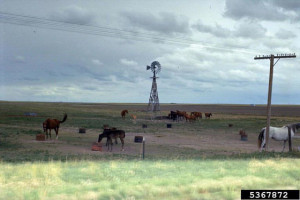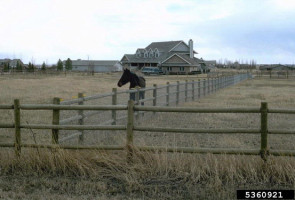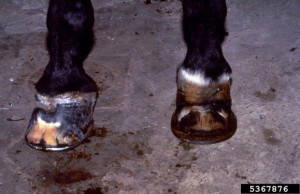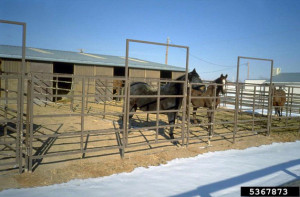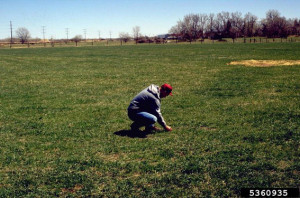Goals for small-acreage horse farm:
- A productive pasture with plenty of grass and few weeds
- Almost no mud during the rainy season
- All nutrients (manure and stall waste) generated by the horses recycled to feed the pasture or removed from the farm and recycled.
- Healthy horses free of problems associated with standing in mud and manure
- Happy owners who are able to conveniently feed and care for their animals without dreading the chore or losing their boots in deep mud.
Recognizing Inter-Connections
The key to meeting the above goals is to recognize that horses, grass, manure, soil, and water are all connected. How you manage one affects the others.
For example, when, where, and how long your animals graze affects grass regrowth, weed competition, and the safety of your well water. How you deal with water runoff affects your horse’s health, nearby streams, and your own enjoyment of the farm.
By managing each aspect of your farm well, the result will be greener pastures, less mud, healthier horses, and more personal satisfaction.
Horse Pastures are Different
To establish and maintain an attractive, green, weed-free pasture, you need to understand several basic principles of plant growth as well as the impact of horses on pastures. To do more than “follow a recipe,” you must learn about plant growth and how pastures fit into the entire horse management system.
Horse pastures are different from other pastures. A green cover, free of weeds and mud, often is the primary objective. Meeting the horse’s nutritional needs frequently is secondary. Nutritional needs likely are met primarily by hay or hay and grain. The pasture usually provides only supplemental feed, exercise, and recreation.
Horse Impacts on Pasture
Horse owners are thrilled by watching their animals run, play, and generally kick up their heels. However, too much of this activity, when concentrated on a small acreage during the wet season can severely damage pastures.
The typical adult horse:
- Weighs about 1,200 pounds
- Has big feet, probably shod in steel
- Loves to run and play
- Possesses a specialized mouth that is one of the world’s most efficient grazing machines.
Horses + Mud/Manure = Health Problems
Living in mud and manure is unhealthy for a horse. Mud harbors bacteria and fungal organisms that cause health problems.
Wet conditions can soften the hoof and sole, causing cracking and splitting and making horses more susceptible to stone bruising and other related lameness.
Thrush is a fungal infection that affects the frog of the hoof and is also caused by wet, muddy conditions.
Horses fed near manure, will also suffer from increased internal parasite infestations.
Horses on wet pastures kill grass and create mud by continuously grazing and trampling grass and churning up the soil with their feet. Because of their size and weight, they also compact the soil. Soil compaction kills plant roots and reduces soil drainage, creating even more mud.
This situation is miserable for both horses and humans, but it doesn’t end there. Because the grass is weakened or killed, weeds now have room to grow. Desirable plants can’t grow in compacted soil, so undesirable plants that are well adapted to these conditions take over. Spring and early summer bring a crop of weeds, some of which are toxic to horses.
The pasture becomes bare in the summer, except for some hardy weeds. Less grass means having to purchase more hay. It also means there is nothing to protect the ground from erosion or to use the nutrients in manure and urine.
1 – Restrict/Control Pasture Access:
Paddock:
The first step to keeping your pasture in good shape and reducing the amount of mud on your farm is to keep your horses off the pasture during the wet season. How do you do this? The answer is to use a paddock—a small enclosure, such as a corral, run, or pen—for your horse’s outdoor living quarters. This area sometimes is called a “sacrifice area” because it is an area of pasture that is “sacrificed” to benefit the rest of the pasture.
Confine your horses to the paddock during the winter and early spring as well as in the summer before your pastures become overgrazed. A paddock also is useful for separating or confining animals, for controlling the amount of grass or feed they consume on a daily basis, and for caring for sick or injured animals.
Locate the paddock on high ground away from water and wells. It should be convenient to your barn or loafing shed to make it easy to care for your horses and to maintain the area. A good option is to have an area set up like a run connected to each stall. This chore-efficient arrangement gives the horse free access to the stall, and you’ll have a clean, dry, convenient place to feed. The size of the area can vary to fit the size of your farm, the number of horses, their ages and temperaments, and other needs.
A general rule is to allow approximately 300–400 square feet per horse. A small paddock the size of a generous box stall (16 x 16 feet) could be adequate for some horses. A larger area that allows for running and playing might be 20–30 feet wide by as much as 100 feet long.
Footing is a crucial part of a paddock. The goal is to have a safe, well-drained, “all-weather” surface. Hog fuel (wood chips or shavings), gravel, and sand all work well for surfacing your paddock.
Fencing:
Horses can be hard on fences, so a hot wire will provide a good psychological barrier. Keep in mind that gates need to be large enough for farm equipment and deliveries of footing material, hay, and so on. Also, to be sure your fence is the correct height, remember to take the thickness of the footing layer into consideration when putting in fence posts. A good height for a paddock fence is 4 feet.
Electric fencing should be placed at the horse’s chest height. Your paddock is an integral part of your pasture rotation system. It is your horses’ outdoor home in the winter. During the grazing season, use it to allow the pasture to recover and to prevent overgrazing.
Maintenance of Paddock:
Pick up manure every 1 to 3 days to prevent the buildup of a soupy surface layer and to reduce insects and parasites. Even the best maintained paddock will have some contaminated runoff. A buffer strip of grass or other vegetation around the paddock will intercept this runoff and prevent it from entering nearby streams or groundwater.
For some horse owners, a reasonable solution for keeping horses off wet pastures is to have them stay at a boarding facility during the winter. Well-managed pastures are an important part of any small horse farm. Horses are grassland animals. They thrive on grazing and exercise. Grazing and moving around a pasture help food move properly through their digestive system. A well-managed pasture can reduce feed costs significantly while providing high-quality forage and exercise.
Healthy grass also keeps water clean by using the nitrogen and phosphorus in manure and urine. It traps and filters runoff carrying soil particles, bacteria, and excess nutrients that otherwise might contaminate household wells and streams.
Poorly managed pastures become muddy in the winter, weedy in the spring, and dust bowls in the summer. Horses forced to stand in mud, manure, and urine all winter can develop health problems— including high levels of parasite infestations—and even hypothermia.
These conditions also lead to large populations of flies and other insects. Mud and manure are bad for horse health as well as for humans and the environment.
Restricting access to pastures and controlling the intensity and duration of pasture use is your most important pasture management responsibility. This controlled grazing can be accomplished by keeping horses in sacrifice areas whenever pastures are not suitable for grazing. Use pastures only when there is adequate green cover and the soil is firm and not water logged.
The number of acres of pasture needed per horse is difficult to determine. If the horses have an adequate exercise lot or are ridden or worked often, they might not need very much pasture. However, most horse owners feel that supplemental pasture grass is good for nutrition and the psychological well-being of the horse. The amount varies widely, however, depending on the amount and frequency of rainfall.
Plants manufacture their food in their leaves, using solar energy, carbon dioxide from the air, and water to make sugars and complex carbohydrates. This process requires “solar receptors” in the green leaf area. Removing too many leaves through overgrazing will slow growth and damage the root system.
Plant regrowth occurs at growing points. One growing point is the collar, the junction of the blade and sheath. The other is the apical meristem, which eventually develops into the seed head. Removal of these growing points by overgrazing will eliminate the plant’s ability to regrow. Susceptibility to overgrazing depends on the species, developmental stage, and other stresses. Learning more about growth and regrowth processes will help you become a better pasture manager.
Most pasture management practices are inexpensive. The key is to develop an attitude that horses do not have to be on grass all of the time or even every day; they should be grazing a pasture only when adequate grass is available and the soil is not saturated.
Keep these top 6 tips in mind as you plan and implement your improvements for your small acreage horse farm:
- Use sacrifice areas most of the time.
- Do not graze pastures when the soil is saturated. Doing so creates mud, damages plants, compacts soil, increases weeds, and reduces grass production.
- Graze no lower than an average of 3 inches in height. This restriction maintains growing points for rapid regrowth and enough leaf area for sunlight absorption, which improves plant health.
- Allow plants to recover after grazing.
- Divide pastures into smaller areas with portable electric fencing.
- Move animals when a paddock has been grazed to allow grass to regrow.

